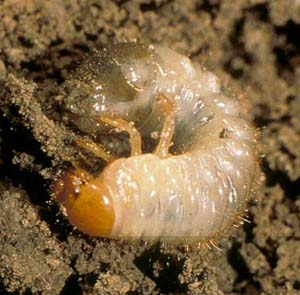White Grubs�� | |
|---|---|
| August 15, 2006 | |
|
The larvae of masked chafers (annual white grub) and Japanese beetle have hatched. We have received several reports of high infestations that are already causing turf dieback. At this time, the C-shaped, white larvae with six legs and brown head capsules are ranging from 1/4 to 1/2 inch long. This is much smaller than the 1-inch length of fully grown grubs. Starlings, robins, and other insectivorous birds have been commonly seen working over lawns, apparently feeding on the white grubs. Typically, these birds feed on sod webworm larvae at this time of year, but the recent rainfalls will have aided the microsporidia in reducing the sod webworm numbers.  To check for white grubs, cut through the sod with a heavy knife and peel it back. The grubs will be in root zone of the turf if the soil is moist. If the soil is dry, the grubs will be a few inches deeper. Tilling up the top 2 to 3 inches of soil with the knife typically exposes the grubs. If there are at least 10 to 12 grubs per foot square, there are enough to cause damage. White grubs feed on the roots of many grass species, causing the grass blades to wilt and turn brown. Heavily attacked turf is easily peeled back because many of the roots have been eaten. The grub numbers are highest in heavily irrigated areas, making them more numerous in golf-course greens and tees and residential front yards. They are also more numerous near sidewalks, cart paths, driveways, and streets because those areas warm the soil next to them during the summer. Grub numbers are be much lower under tree canopies.  Imidacloprid (Merit) and halofenozide (Mach 2) can still be applied, but the grubs will not die for about 3 weeks. Although feeding appears to be reduced during this time, live grubs will still be present and obvious to golfers and curious homeowners. Trichlorfon (Dylox) is usually a better option at this time of year because it kills the grubs within 3 days. It lasts for only about 5 days, so be sure that the grubs are present and up in the turf root zone. Water any grub application into the root zone where the grubs are feeding, with at least 1/2 inch of irrigation. This irrigation also serves to bring white grubs that are deeper in the soil up into the root zone, where they contact the insecticide.�� | |
| Author: | Phil Nixon |
